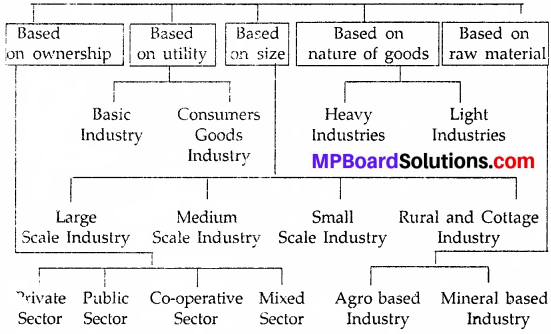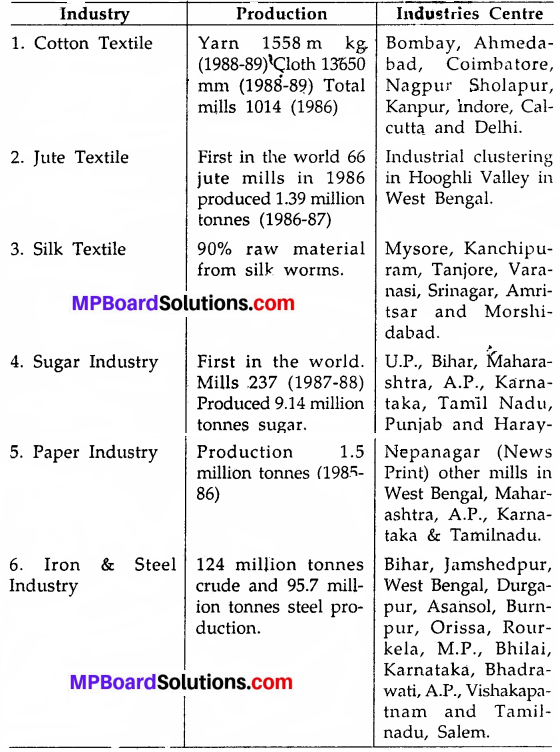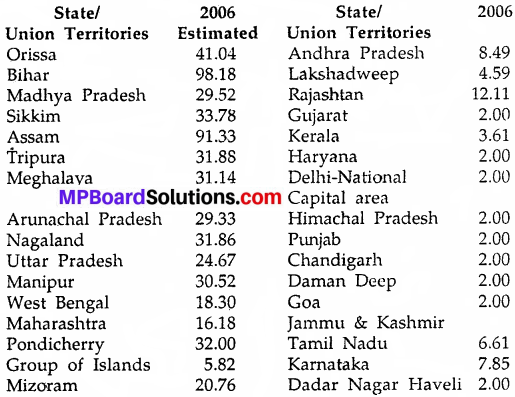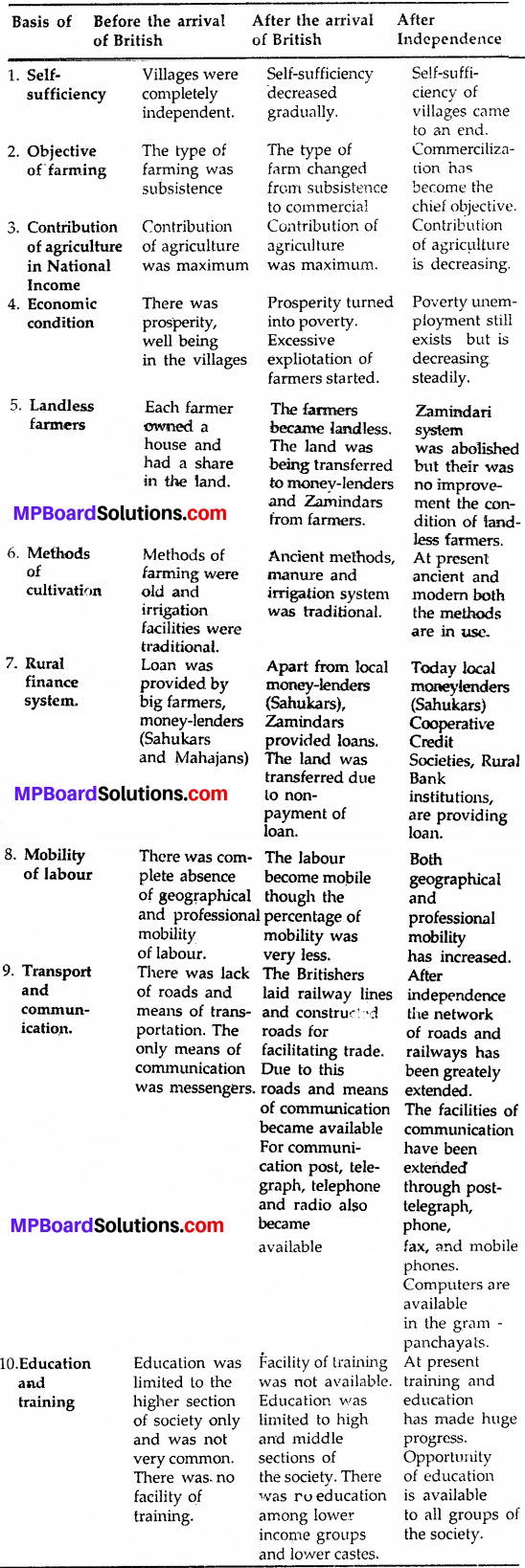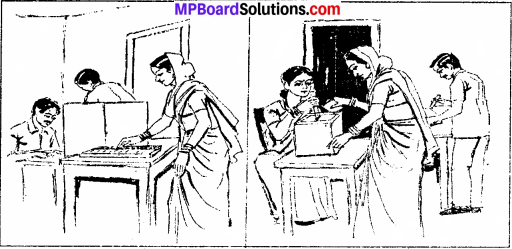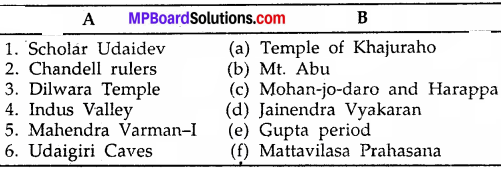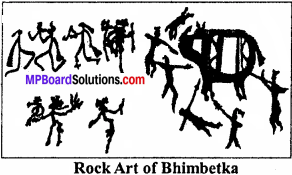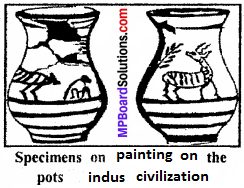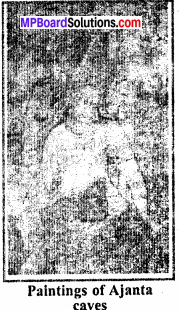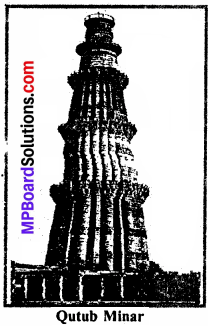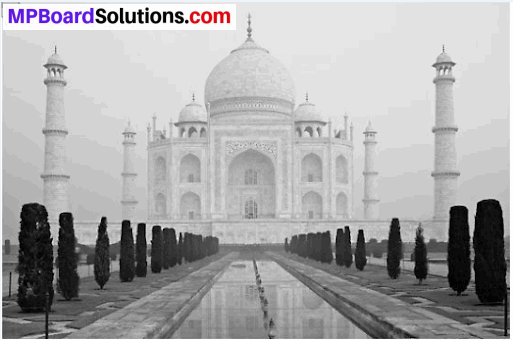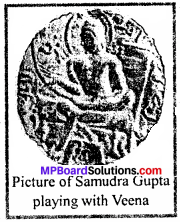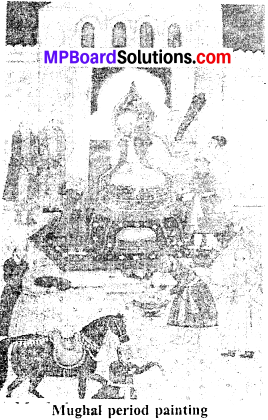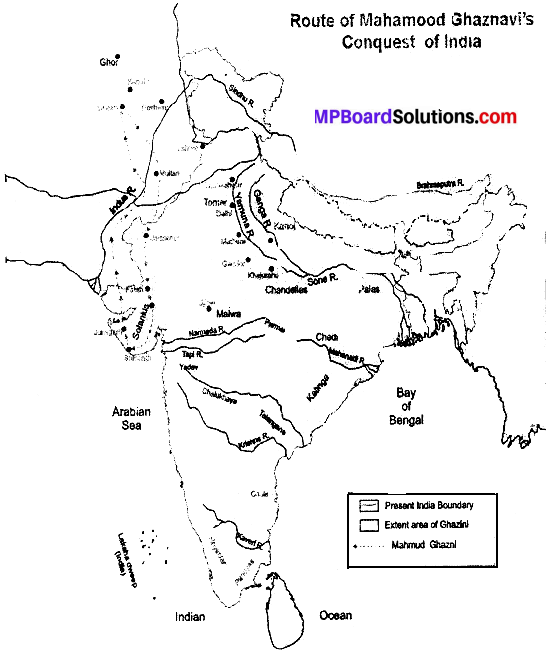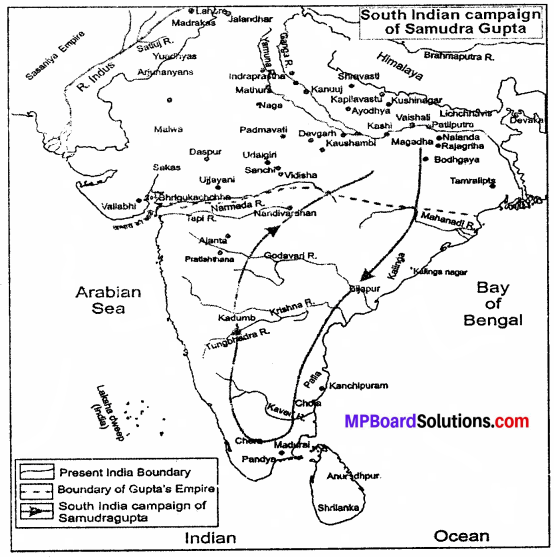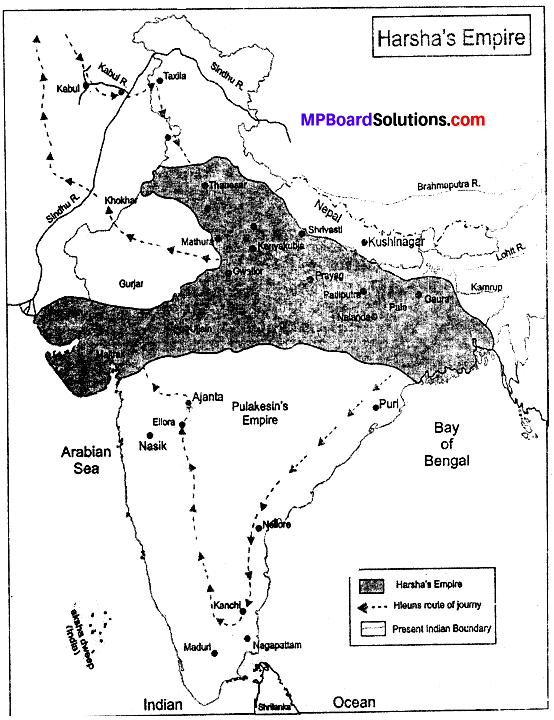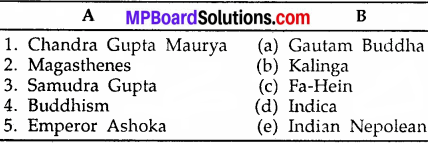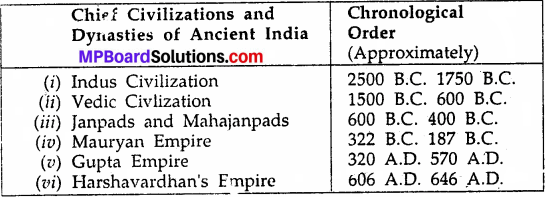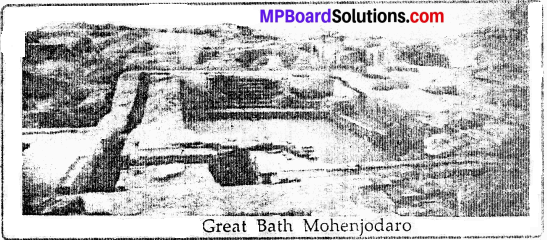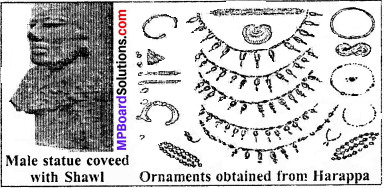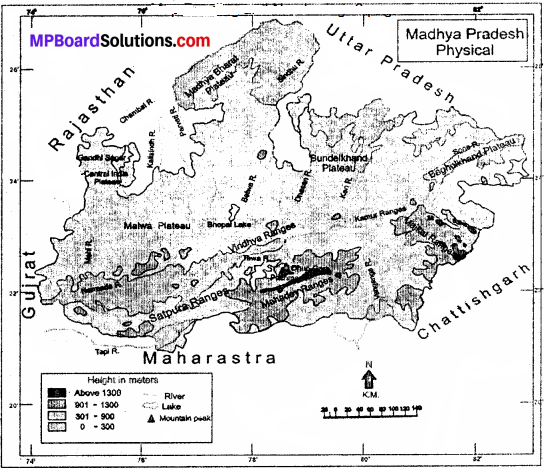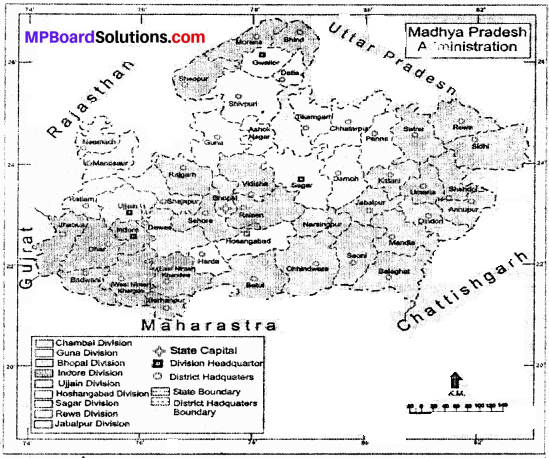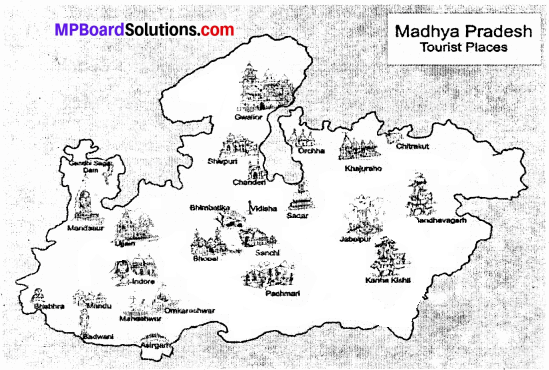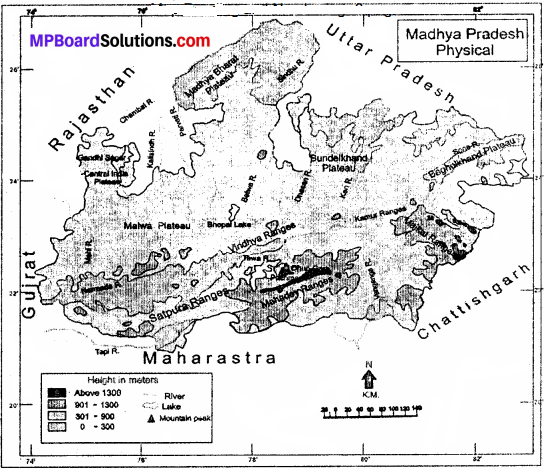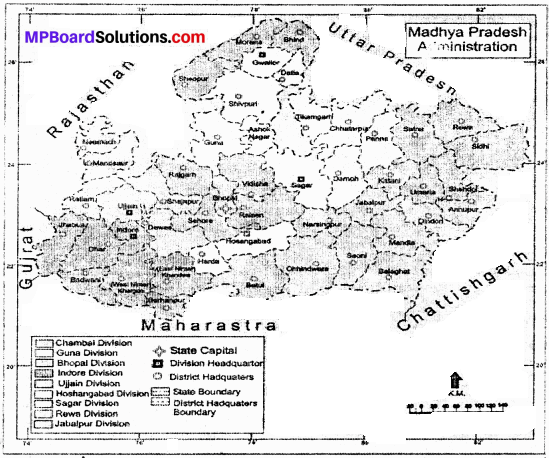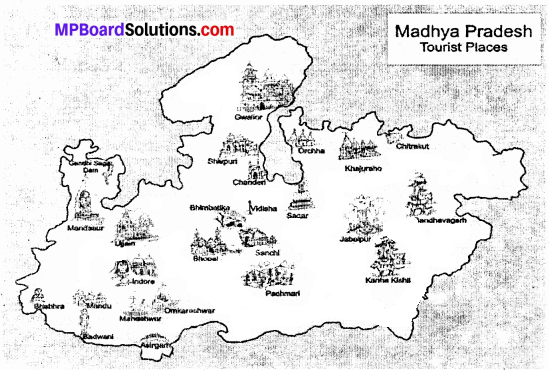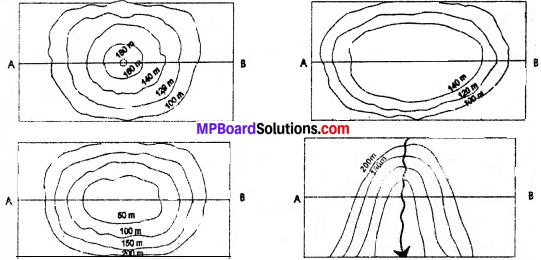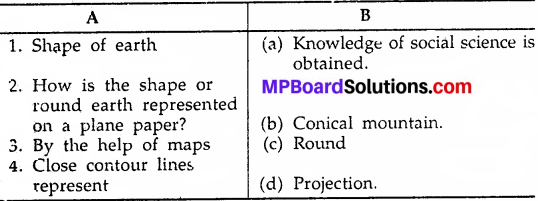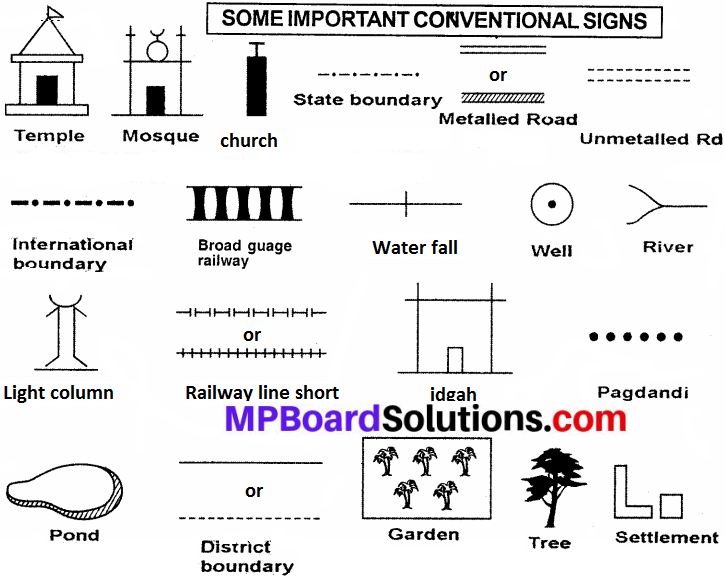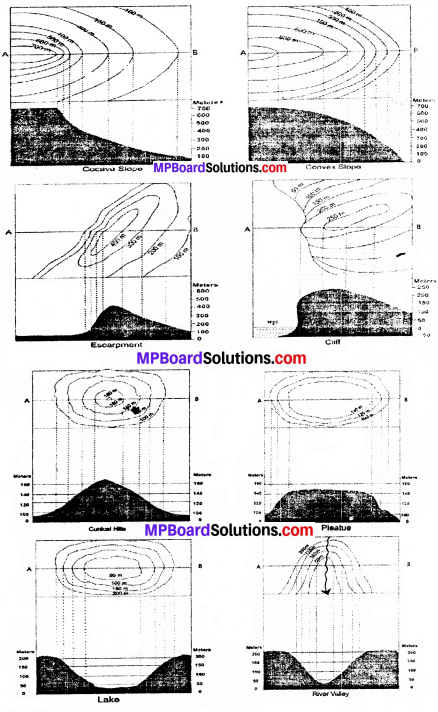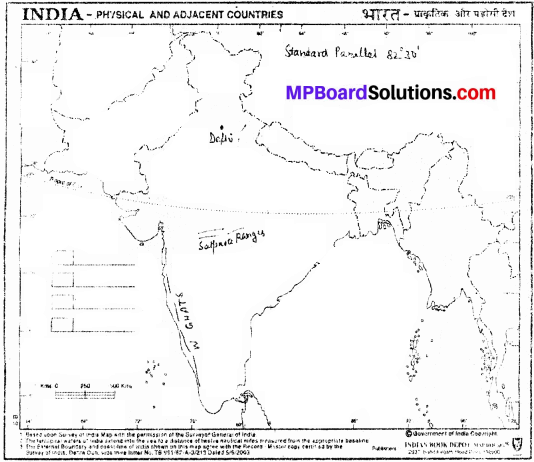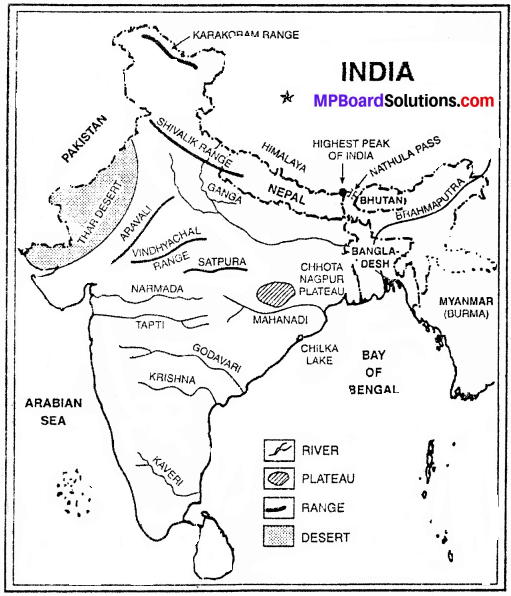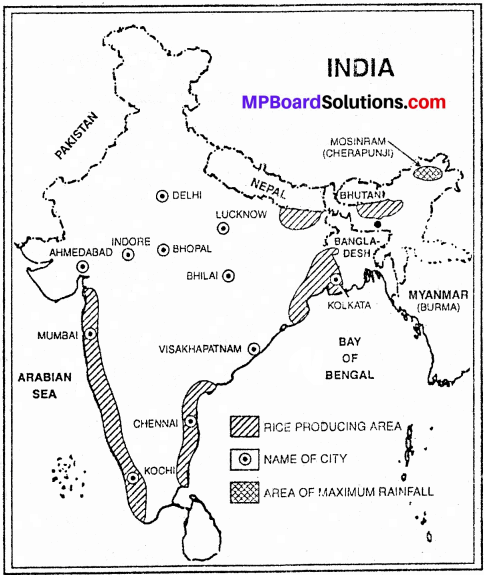MP Board Class 9th Social Science Solutions Chapter 18 Food Security in India
MP Board Class 9th Social Science Chapter 18 Text Book Questions
Choose the Correct Answer:
Question 1.
Kharif crop is –
(a) Wheat
(b) Gram
(c) Paddy
(d) Oat.
Answer:
(c) Paddy
Question 2.
The part of Public Distribution System is –
(a) Shoe shop
(b) Gold & Silver shop
(c) Ration shop
(d) Grocery shop.
Answer:
(c) Ration shop
Question 3.
Target-ted public distribution is related to –
(a) Women
(b) Gents
(c) People living below the poverty line
(d) None of these.
Answer:
(c) People living below the poverty line
Question 4.
How much cereal is given under Antyodaya Anna Yojna –
(a) 5 kg
(b) 10 kg
(c) 15 kg
(d) 25 kg.
Answer:
(d) 25 kg.
![]()
MP Board Class 9th Social Science Chapter 18 Very Short Answer Type Questions
Question 1.
Write the names of coarse cereal.
Answer:
Sorghum (Jowar), bajra (pearl millet) and maize.
Question 2.
In which years did India face famine?
Answer:
India had to face famine is the years 1835, 1877 and 1943.
Question 3.
What is Rojgar Ashwasan Yojna?
Answer:
Under Rojgar Ashwasan Yojna 100 days employment can be provided to 18 – 60 year old unskilled labor so that they are able to earn and purchase food grains through revamped public distribution system.
Question 4.
What is meant by minimum support price?
Answer:
Declaration of support price of agricultural crops means to give the guarantee of a minimum price to farmers for their crops.
Question 5.
Write the names of any two schemes launched for food security.
Answer:
- Target-ted public distribution system
- Kam Ke Badle Anaj Yojna.
![]()
MP Board Class 9th Social Science Chapter 18 Short Answer Type Questions
Question 1.
What are the main factors of food security? Write about them.
Answer:
The main factors of food security are –
- Availability of food to the whole population of the country.
- Availability of enough money (purchasing power) to purchase the available food.
- Food should be available to all at affordable prices.
- The quality of the available food should be good.
Question 2.
What is Buffer Stock? Explain.
Answer:
if the production of food grains is less then to face such crisis of shortage and to distribute them through Public Distribution System, the stock of food grains kept by the government is known as Buffer Stock. Buffer Stock is the stock of food grains namely wheat and rice procured by government through Food Corporation of India (FCI).
The FCI purchases wheat and rice from farmers in states where there is surplus production. These food grains are stored in large granaries. It helps in resolving the problem of shortage of food grains during emergencies.
Question 3.
Explain Target-ted Public Distribution System.
Answer:
In 1997 target-ted Public Distribution System was introduced to ensure the availability of minimum quantity of food grains to families living below the poverty line. In this system food grains are provided to the poor on special low prices by issuing specific ration cards.
This is the largest food security plan of the world. In this system 3.5 kg. of food grains per month per family is being provided from 1st April, 2006. In the same way under the “Antyodaya Anna Yojna” 25 kg. of wheat at. Rs. 2/- per kg. and rice at Rs. 3/- per kg. is being provided to very poor families through Public Distribution System.
Under this system a differential price system was adopted including people below the poverty line (BPL) and also for people above the poverty line (APL)- in which prices of wheat and rice are fixed.
![]()
Question 4.
What is Revamped Public Distribution System? Explain.
Answer:
Revamped Public Distribution System In January 1992, the Public Distribution System was amended and a revised Public Distribution System was introduced to supply essential goods to consumers of remote area, schedule tribes, backward classes, drought – affected and mountainous areas of the country. Its characteristics are as follows:
1. Preference has been given to the people of drought – affected areas, desert areas, mountainous area and slums in urban areas.
2. It is aimed at providing more quantity of food at comparatively low prices. Other than six chief essential commodities goods like tea, soap, pulse, iodized salt are included in it.
3. Rojgar Aswan Plan has been started in the development blocks included under this plan, in which 100 days employment can be provided tr 18 – 60 – year – old unskilled labor so that they are able to earn and purchase food-grains through Revamped Public Distribution System.
Question 5.
What is the role of cooperative in food security? Explain.
Answer:
In India the role of cooperative is very important in providing food security. This work is done by the consumer cooperative societies through the ration shops for the sale of food grains for the poor. In India there are different system of consumer cooperatives at national, state, district and village levels.
Out of these National Consumers. Cooperative (Federation) Ltd. is an organization at national level. State Cooperative Consumers’ Organization is affiliated to this forum (federation). There are 794 consumer cooperative stores at central level (wholesale) and 24,078 stores’at primary level.
In rural areas nearly 44,418 village level primary agricultural credit society are distributing essential goods along with their ordinary business. To fulfill the needs of consumers, consumer cooperative societies are running nearly 37,226 retail selling centers in urban and semi – urban areas.
![]()
Question 6.
Differentiate between Kharif and Rabi Crops.
Answer:
Kharif:
- Kharif crops are shown in June or early July and harvested at tire end of Monsoon. This means sowing is done at the onset of monsoon (June and July) while harvesting is done at the end of Monsoon (October and November).
- Kharif crops are rice, jowar, maize, millet, groundnut, jute and cotton pulses are also grown in this session.
- Kharif crops are of tropical climate. (Some changes in this pattern take place, see the note in bracketed column of rabi crop.)
Rabi:
- Rabi crop season starts in November-December and hares – ting .takes place in the months of April and May.
- the major rabi crops are – wheat, barley, gram,, linseed, rasped and mustard.
- in the southern half of the Indian peninsula where temperatures are sufficiently high and rain occurs in winters this classification become blurred. Crops like Jowar are grown in.
MP Board Class 9th Social Science Chapter 18 Long Answer Type Questions
Question 1.
What are the major cereals of India? Describe.
Answer:
India is an agricultural country and the chief occupations is farming. Cereals are grown is about 70 to 80% of the total agricultural land. rice, wheat millers and maize are the major cereals.
1. Rice:
Rice is the staple food crap of India. It thrives well in hot and humid climate. It requires temperature of 25°C, and rainfall of 100 cm and above and loamy fertile soil. The chief rice producing areas in India are the coastal strips, the Gainga Plains, the Brahmaputra valley, the deltas of Godavari, Krishna and Kaveri.
High yielding varieties, improved planting techniques, irrigation facilities and use of fertilizers have enabled Sadie to increase the production of rice in 1985-86 to 61 million tonnes and average yield per hectare rose to 15.7 Quintilian (2 \(\frac { 1}{2}\) tonnes, increase)
2. Wheat:
Wheat is the second important food crop of India. It requires a cool and moist climate during growing season and a dry climate at the time of ripening. Annual rainfall of 50 to 75 cm and fertile and sandy soil is very suitable – The chief wheat growing areas are Punjab, Haryana IIP, Bihar, MP., Rajashtan Maharashtra, etc.
because all the conditions far wheat production are found here. The use of high yielding varieties,, fertilizers and irrigation facilities helped to raise fire average yield per acre and increased the production of wheat 51 million mark in 1985 – 89. This breakthrough in the production of wheat is called the Green Resolution.
3. Millets:
Sorghum (Jo-war) and bajra are important millets in India. Sorghum (Jowar) In India Jowar has been grown from ancient period. It is used as fodder for cattle and as a food for human beings. In India it is food of the poor, ha foreign countries it is used to prepare starch and glucose.
In northern India it is a Kharif crop but in southern India it is a crop of Kharif and Rabi both. About 87 percent of the total production of Jowar (sorghum) in the country is produced in Madhya Pradesh, Maharashtra, Karnataka and Andhra Pradesh.
4. Bajra:
It is a Kharif crop in northern India. In southern India it is a crop of Rabi and Kharif both. It is used as fodder for cattle. India is the largest producer of Bajra in the world, hi India main Bajra producing states are Rajasthan, Gujarat, Maharashtra, Uttar Pradesh, Tamilnadu, Haryana, Karnataka, Andhra Pradesh and Punjab. Of the total production of Bajra in the country 96 per cent is grown here.
5. Maize:
Maize is the crop of plains and mountainous region. It is used as fodder for cattle and as food to eat. Man uses its different varieties for food products. In foreign countries starch and glucose are prepared from this. In India it is grown in about all states but mainly it is grown in Uttar Pradesh, Punjab, Bihar, Madhya Pradesh, Rajasthan, Gujarat and Karnataka.
![]()
Question 2.
What is food security and why is it necessary? Explain.
Answer:
Food security related to the food – related needs of man. In simple words food security means availability of nutritive food to all. Also people should have purchasing power (money) for the arrangement and availability of food at reasonable prices. According to the World Development Report, 1986 “Food security is the availability of adequate food at all time for active and healthy life for all”.
Necessity of Food Security:
In the present Indian situation food security has become very important. Our economy is developing but the population is also increasing rapidly. So to meet the increasing demand, food security has become necessary. The causes responsible for this can be divided into two parts internal causes and external causes.
I. Internal causes:
Internal causes include those which are related to the internal conditions of the country. Following factors are included in these.
1. Basis of life:
India is a country of large population and the birth rate is also very high. Therefore food security is necessary.
2. Dependence on Monsoon:
Majority of crops in India are dependent on monsoon for irrigation, but the monsoon is always uncertain and irregular. The distribution of rains is uneven too. Consequently droughts and famines are common features of our economy. Therefore food security is necessary.
3. Low Productivity:
In India the productivity of food grains regarding per hectare and per labor is low. From this point of view also food security is necessary.
4. Natural Calamities:
Other than the problem of monsoon, flood, insects and pets, cold waves, soil erosion etc. also destroy the food crops in some or the – other part of the country. So the problem of shortage of food crops arises. The famine in Orissa of 1835 in Punjab and Madhya Pradesh in 1877 and in West Bengal in 1943, lacks of people died of hunger. So food security is necessary to face these natural calamities.
5. Continuously Rising Prices:
The prices of food grains are increasing continuously which results in starvation. So food security is necessary to overcome this problem.
6. Progress of the Country:
No country can progress without self-sufficiency of food, and for this food security is necessary.
II. External causes:
External causes include those causes which are related to the relation of the other countries with our country. Following are the external causes:
1. Dependence on Foreign Countries:
Food is the basic need of human beings. So when this requirement is not fulfilled it becomes the primary duty of the Government to fulfill these needs of the people. If there is a shortage of food we have to depend on foreign countries. Whenever there is inadequate supply of food-grains in our country we have to import even if food graii are costly or cheap the quality is good or bad. Thus dependence on foreign countries increases.
2. Decrease in Foreign Exchange:
Whenever we import things like food grains we have to spend our foreign exchange unnecessarily. We can meet our demand for food ourselves but we cannot. This results in shortage of foreign exchange to purchase very important commodities.
3. Foreign Pressure:
Countries which supply food grains to other countries become influential and then they pursue them to follow their policies. These countries dominate those countries which import food grains from them, as a result they lose their freedom to decide their foreign policies.
In the year 1965 – 66 and 1966 – 67 due to the failure of monsoon India had to face a devastating drought and therefore wheat was imported from America. During these frequent emergencies of food grains India experienced that food security is very essential to save people from starvation, to protect self – respect that honor and sovereignty and for the development of the country.
![]()
Question 3.
How does the government provide food security to the poor? Explain.
Answer:
Government provides food security to the poor through the following measures:
- Public Distribution System.
- Alertness of Government
- Measures taken in a Critical Situation.
1. Public Distribution System:
By Public Distribution System is meant that system in which different consumer goods are sold in sufficient quantity of fixed prices to the consumers specially to the poor section of society. In this system different goods such as wheat, rice, sugar, imported edible oil, coal and kerosene oil etc. are sold through ration shops or cooperative consumer stores.
The profit rate for these sellers ’are fixed and they have to sell the goods to the ration card holders on fixed price and in fixed quantities. There are three kinds of ration cards B.P.L. card, A.P.L card and Antyodaya cards. BPL cards are meant for those people who are below poverty line, APL cards are meant for those people who are above poverty line and Antyodaya cards are issued to those people who are the poorest of the poor.
The Public Distribution System is regulated by central and state government together. The central government allots food grains and other commodities to state and determines prices also. The state has the right to add transportation charges etc. to the prices fixed by Central Govt.
The transportation, collection, distribution and inspection of these goods processed under this system is done by state government. It is clear from the above table that Public Distribution System plays an important role in providing food-grains to people.
The state government can include those goods also in Public Distribution System which it can purchase if required. In India distribution of food-grains is increasing continuously through Public Distribution System as shown in the given table:
Public Distribution System and Distribution of Food Grains:

2. Alertness of Government:
Our government is very alert in providing food security to the poor. It has developed food security system to make food grains available at reasonable prices to the poor and other people.
3. Measures Taken in a Critical Situation:
The government takes several steps in order to make food grains available to the poor during the period of food crisis arising due to any other reasons or due to natural calamities. Some of these measures are given below:
I. Efforts to Increase Food Grains:
For food security it is important that the production of food grains should be enough in quantity. In this the contribution of green revolution is quite important under Green Revolution mechanization of agriculture, use of high yielding hybrid variety of seeds, fertilizers and insecticides and irrigation facilities were extended.
Also due to promotion of consolidation of land holdings, abolishing of mediators, today the country has become self-sufficient in the field of food grains. The progress of food grains in India can be explained on the basis of following table:
Food Grain Production in India (in crore tonnes):

II. Minimum Support Price:
The prices of agriculture products are very flexible, at the time of harvesting the supply increases, due to which there is enough decrease in price. As prices at this time go down below the fixed limit the producer finds it difficult to get the cost of their products.
1. Therefore government declares minimum support price for agricultural products, under which when market price of food-grains becomes less than its support price, the government starts purchasing food grains on self-declared support price. Due to which farmers get inspired to produce more and more and the government procures food grain for “Buffer Stocks”.
2. The support prices declared by the government during last years are shown here in following table:
Support of Different Food Grains (Rupees per quintal):

III. Buffer Stock:
If the production of food grains is less than to face such crisis of shortage and to distribute them through Public Distribution System, the stock of food grains kept by government is known as Buffer Stock. Buffer stock is the Stock of food grains, namely wheat and rice procured by government through Food Corporation of India (FCI).
The FCI purchases wheat and rice from farmers in states where there is surplus production. The farmers are paid a pronounced price for their crop. This price is called “Minimum Support Price”. The government declares these prices before the sowing season to provide incentives to farmers for raising production of these crops.
These food grains are stored in large granaries. It helps in resolving the problem of shortage of food grains during emergencies. The table of Buffer Stock explains that in the past years in India the stocks has been greater than fixed minimum quantity which is a sign of strong food security of India.
Status of Buffer Stock in India (in million tonnes):

![]()
Question 4.
What steps has the government taken to increase food grains?
Answer:
Government provides food security to the poor through the following measures:
- Public Distribution System.
- Alertness of Government
- Measures taken in a Critical Situation.
1. Public Distribution System:
By Public Distribution System is meant that system in which different consumer goods are sold in sufficient quantity of fixed prices to the consumers specially to the poor section of society. In this system different goods such as wheat, rice, sugar, imported edible oil, coal and kerosene oil etc. are sold through ration shops or cooperative consumer stores.
The profit rate for these sellers ’are fixed and they have to sell the goods to the ration card holders on fixed price and in fixed quantities. There are three kinds of ration cards B.P.L. card, A.P.L card and Antyodaya cards. BPL cards are meant for those people who are below poverty line, APL cards are meant for those people who are above poverty line and Antyodaya cards are issued to those people who are the poorest of the poor.
The Public Distribution System is regulated by central and state government together. The central government allots food grains and other commodities to state and determines prices also. The state has the right to add transportation charges etc. to the prices fixed by Central Govt.
The transportation, collection, distribution and inspection of these goods processed under this system is done by state government. It is clear from the above table that Public Distribution System plays an important role in providing food-grains to people.
The state government can include those goods also in Public Distribution System which it can purchase if required. In India distribution of food-grains is increasing continuously through Public Distribution System as shown in the given table:
Public Distribution System and Distribution of Food Grains:

2. Alertness of Government:
Our government is very alert in providing food security to the poor. It has developed food security system to make food grains available at reasonable prices to the poor and other people.
3. Measures Taken in a Critical Situation:
The government takes several steps in order to make food grains available to the poor during the period of food crisis arising due to any other reasons or due to natural calamities. Some of these measures are given below:
I. Efforts to Increase Food Grains:
For food security it is important that the production of food grains should be enough in quantity. In this the contribution of green revolution is quite important under Green Revolution mechanization of agriculture, use of high yielding hybrid variety of seeds, fertilizers and insecticides and irrigation facilities were extended.
Also due to promotion of consolidation of land holdings, abolishing of mediators, today the country has become self-sufficient in the field of food grains. The progress of food grains in India can be explained on the basis of following table:
Food Grain Production in India (in crore tonnes):

II. Minimum Support Price:
The prices of agriculture products are very flexible, at the time of harvesting the supply increases, due to which there is enough decrease in price. As prices at this time go down below the fixed limit the producer finds it difficult to get the cost of their products.
1. Therefore government declares minimum support price for agricultural products, under which when market price of food-grains becomes less than its support price, the government starts purchasing food grains on self-declared support price. Due to which farmers get inspired to produce more and more and the government procures food grain for “Buffer Stocks”.
2. The support prices declared by the government during last years are shown here in following table:
Support of Different Food Grains (Rupees per quintal):

III. Buffer Stock:
If the production of food grains is less than to face such crisis of shortage and to distribute them through Public Distribution System, the stock of food grains kept by government is known as Buffer Stock. Buffer stock is the Stock of food grains, namely wheat and rice procured by government through Food Corporation of India (FCI).
The FCI purchases wheat and rice from farmers in states where there is surplus production. The farmers are paid a pronounced price for their crop. This price is called “Minimum Support Price”. The government declares these prices before the sowing season to provide incentives to farmers for raising production of these crops.
These food grains are stored in large granaries. It helps in resolving the problem of shortage of food grains during emergencies. The table of Buffer Stock explains that in the past years in India the stocks has been greater than fixed minimum quantity which is a sign of strong food security of India.
Status of Buffer Stock in India (in million tonnes):

![]()
Question 5.
What is Public Distribution System and what are its main constituents? Describe.
Answer:
By Public Distribution System is meant that system in which different consumer goods are sold in sufficient quantity at fixed prices to the consumers specially to the poor section of society. In this system different goods (wheat, rice, sugar, imported edible oil, coal and kerosene oil etc.) are sold through ration shops or cooperative consumer stores.
The profit rate for these sellers are fixed and they have to sell the goods to the ration card holders on fixed price and in fixed quantities. There are three kinds of ration cards BPL Card, APL Card and Antyodaya Card. BPL cards are for people below poverty line. APL cards are for people above poverty line.
Antyodaya Cards are meant for the poorest of the poor. The Public Distribution System is regulated by central and state government together. The central government allots food grains and other commodities to state and determines prices also. The state has the right to add transportation charge etc.
to the prices fixed by Central Government. The transportation, collection, distribution and inspection of these goods processed under this system is-done by state government. The state government can include those goods also in Public Distribution System which it can purchase if required.
The main constituents of Public Distribution System. Public Distribution System includes fair-price shops. Fair Price Shop for selling cloth, soft coke depot, Super market and Kerosene shops. In India distribution of food grains is increasing continuously through Public Distribution System. The following table will show that Public Distribution system plays an important role in providing food grains to people.
Public Distribution System and Distribution of Food Grains (in million tonnes):

![]()
Question 6.
How is the Public Distribution System conducted? Describe.
Answer:
By Public Distribution System is meant that system in which different consumer goods are sold in sufficient quantity at fixed prices to the consumers specially to the poor section of society. In this system different goods (wheat, rice, sugar, imported edible oil, coal and kerosene oil etc.) are sold through ration shops or cooperative consumer stores.
The profit rate for these sellers are fixed and they have to sell the goods to the ration card holders on fixed price and in fixed quantities. There are three kinds of ration cards BPL Card, APL Card and Antyodaya Card. BPL cards are for people below poverty line. APL cards are for people above poverty line.
Antyodaya Cards are meant for the poorest of the poor. The Public Distribution System is regulated by central and state government together. The central government allots food grains and other commodities to state and determines prices also. The state has the right to add transportation charge etc.
to the prices fixed by Central Government. The transportation, collection, distribution and inspection of these goods processed under this system is-done by state government. The state government can include those goods also in Public Distribution System which it can purchase if required.
The main constituents of Public Distribution System. Public Distribution System includes fair-price shops. Fair Price Shop for selling cloth, soft coke depot, Super market and Kerosene shops. In India distribution of food grains is increasing continuously through Public Distribution System. The following table will show that Public Distribution system plays an important role in providing food grains to people.
Public Distribution System and Distribution of Food Grains (in million tonnes):

![]()
MP Board Class 9th Social Science Chapter 18 Other Important Questions
Question 1.
Choose the right answer:
(i) Kharif crops are sown in the month of –
(a) October
(b) November
(c) December
(d) January
Answer:
(a) October
Question 2.
Rabi crops are harvested in the month of –
(a) February or March
(b) March or April
(c) April or May
(d) May or June.
Answer:
(b) March or April
Question 3.
In production of food grains India stands third after –
(a) America and Australia
(b) America and China
(c) America and Canada
(d) China and Canada.
Answer:
(b) America and China
Question 4.
Antyodaya ration cards are meant for those who are –
(a) Below poverty line
(b) Above poverty line
(c) Poorest of the poor
(d) None of the above.
Answer:
(c) Poorest of the poor
Question 5.
Target-ted Public Distribution System was introduced in the year –
(a) 1997
(b) 1998
(b) 1999
(d) 2000.
Answer:
(a) 1997
Fill in the blank:
- Reserve stock of food grains to meet …………… situations.
- ……………. cards for people below poverty line.
- ……………. cards for the poorest of the poor.
- In India two kinds of wheat are grown……………… and mikrani wheat.
- India is second largest producer of ………………… in the world.
Answer:
- Emergency
- BPL
- Antyodaya
- Walgair wheat
- Rice.
![]()
MP Board Class 9th Social Science Chapter 18 Very Short Answer Type Questions
Question 1.
Name the main requirements of life?
Answer:
Food, clothing and housing.
Question 2.
How does the World Development Report 1986? Define Food security.
Answer:
According to the World. Development Report 1986, “Food security is the availability of adequate food at all time for active and healthy life for all”.
Question 3.
On what three factors does food security depend?
Answer:
Food security depends on three factors Public Distribution System, alertness of government and the measures taken in a situation of crisis.
Question 4.
Name the major cereals?
Answer:
The major Cereals are rice, wheat, mullets and maize.
![]()
Question 5.
Name some rabi crops?
Answer:
Some rabi crops are wheat, oat, gram, etc.
Question 6.
Name rice producing states of India?
Answer:
Rice producing states of India are West Bengal, Uttar Pradesh, Andhra Pradesh, Chhattisgarh, Madhya Pradesh, Bihar, Tamil Nadu, Orissa, Punjab amd Assam.
Question 7.
When was Public Distribution System amended?
Answer:
Public Distribution System was amended in January 1992.
Question 8.
What are the parts of Public Distribution System?
Answer:
Public Distribution System includes fair price shops, soft coke depot, super market and kerosene shops.
Question 9.
Name two crops used as fodder for cattle?
Answer:
Jowar and Bajra.
![]()
Question 10.
What type of economy have we?
Answer:
We have developing economy.
MP Board Class 9th Social Science Chapter 18 Short Answer Type Questions
Question 1.
What does food security generally imply? Mention the stages of food security?
Answer:
The food security generally implies that the whole population at all time, should have access to minimum quantity of cereals, but due to continuous changes in a developing country there can be following stages of food security:
- Availability of adequate food grains.
- Availability of food grains and pulses in adequate quantity.
- Availability of milk and milk products along with food grains and pulses.
- Availability of food-grains, pulses, milk and milk products, vegetables, fruits etc.
Question 2.
Describe the chief crops of India and their cultivation regions.
Answer:
The chief crops of India paddy (rice), wheat, bajra, jowar, maize, gram and pulses. Their cultivation regions
1. Paddy (rice):
West Bengal, Uttar Pradesh, Andhra Pradesh, Chhattisgarh, Madhya Pradesh, Bihar, Tamilnadu, Orissa, Punjab, Assam.
2. Wheat:
Uttar Pradesh, Punjab, Haryana, Madhya Pradesh, Bihar, Rajasthan, Maharashtra, West Bengal, Uttarakhand, Gujarat.
3. Bajra:
Rajasthan, Maharashtra, Tamilnadu, Punjab, Uttar Pradesh, Gujarat.
4. Jowar:
Madhya Pradesh, Maharashtra, Karnataka, Andhra Pradesh.
5. Maize:
Uttar Pradesh, Karnataka, Andhra Pradesh, Madhya Pradesh, Punjab, Bihar, Rajasthan.
6. Gram & Pulses:
Madhya Pradesh, Uttar Pradesh, Maharashtra, Punjab, Karnataka.
![]()
Question 3.
What do you understand by ‘Fair Price Shop’? What are its benefits?
Answer:
Sugar, cereals, kerosene etc. are distributed to the ration card holders through ration shops which are also known as ‘Fair Price Shops’. Any family with a ration card can buy stipulated amount of these items, every month from nearby ration shop. At these shops all the items are sold at a price lower than the market price. Today there are about 4.6 lakh ration shops in the country.
Question 4.
Write a short note on Buffer Stock?
Answer:
If the production of food grains is less than to face such crises of shortage and to distribute them through Public Distribution System, the stock of food grains kept by government is known as Buffer Stock. Buffer Stock is the stock of food grains namely wheat and rice procured by government through Food Corporation of India (FCI).
The FCI purchases wheat and rice from farmers in states where there is surplus production. These food grains are stored in large granaries. It helps in resolving the problem of shortage of food grains during emergencies.
MP Board Class 9th Social Science Solutions Chapter 18 Food Security in India
Question 1.
Describe coarse crops.
Answer:
Sorghum (Jowar), bajra and maize are coarse crops.
1. Sorghum (Jowar):
Jowar is used as fodder for cattle and as food for human beings. In India it is food of the poor and in foreign countries it is used to prepare starch and glucose. About 87% of the total production of jowar in the country is produced in Madhya Pradesh, Maharashtra, Karnataka and Andhra Pradesh.
2. Bajra:
It is used as fodder for cattle. India is the largest producer of bajrai in the world. The main bajra producing states of India are Rajasthan, Gujarat, Maharashtra, Uttar Pradesh, Tamilnadu, Haryana etc. Of the total production of bajra in the country 96% is grown here.
3. Maize:
It is used as food and fodder. In India it is grown in about all states but mainly it is grown in Uttar Pradesh, Punjab, Bihar, Madhya Pradesh, Rajasthan, Gujarat and Karnataka.
![]()
Question 2.
Why has food security become necessary in India? What are the causes responsible for this?
Answer:
Food security related to the food – related needs of man. In simple words food security means availability of nutritive food to all. Also people should have purchasing power (money) for the arrangement and availability of food at reasonable prices. According to the World Development Report, 1986 “Food security is the availability of adequate food at all time for active and healthy life for all”.
Necessity of Food Security:
In the present Indian situation food security has become very important. Our economy is developing but the population is also increasing rapidly. So to meet the increasing demand, food security has become necessary. The causes responsible for this can be divided into two parts internal causes and external causes.
I. Internal causes:
Internal causes include those which are related to the internal conditions of the country. Following factors are included in these.
1. Basis of life:
India is a country of large population and the birth rate is also very high. Therefore food security is necessary.
2. Dependence on Monsoon:
Majority of crops in India are dependent on monsoon for irrigation, but the monsoon is always uncertain and irregular. The distribution of rains is uneven too. Consequently droughts and famines are common features of our economy. Therefore food security is necessary.
3. Low Productivity:
In India the productivity of food grains regarding per hectare and per labor is low. From this point of view also food security is necessary.
4. Natural Calamities:
Other than the problem of monsoon, flood, insects and pets, cold waves, soil erosion etc. also destroy the food crops in some or the – other part of the country. So the problem of shortage of food crops arises. The famine in Orissa of 1835 in Punjab and Madhya Pradesh in 1877 and in West Bengal in 1943, lacks of people died of hunger. So food security is necessary to face these natural calamities.
5. Continuously Rising Prices:
The prices of food grains are increasing continuously which results in starvation. So food security is necessary to overcome this problem.
6. Progress of the Country:
No country can progress without self-sufficiency of food, and for this food security is necessary.
II. External causes:
External causes include those causes which are related to the relation of the other countries with our country. Following are the external causes:
1. Dependence on Foreign Countries:
Food is the basic need of human beings. So when this requirement is not fulfilled it becomes the primary duty of the Government to fulfill these needs of the people. If there is a shortage of food we have to depend on foreign countries. Whenever there is inadequate supply of food-grains in our country we have to import even if food graii are costly or cheap the quality is good or bad. Thus dependence on foreign countries increases.
2. Decrease in Foreign Exchange:
Whenever we import things like food grains we have to spend our foreign exchange unnecessarily. We can meet our demand for food ourselves but we cannot. This results in shortage of foreign exchange to purchase very important commodities.
3. Foreign Pressure:
Countries which supply food grains to other countries become influential and then they pursue them to follow their policies. These countries dominate those countries which import food grains from them, as a result they lose their freedom to decide their foreign policies.
In the year 1965 – 66 and 1966 – 67 due to the failure of monsoon India had to face a devastating drought and therefore wheat was imported from America. During these frequent emergencies of food grains India experienced that food security is very essential to save people from starvation, to protect self – respect that honor and sovereignty and for the development of the country.
